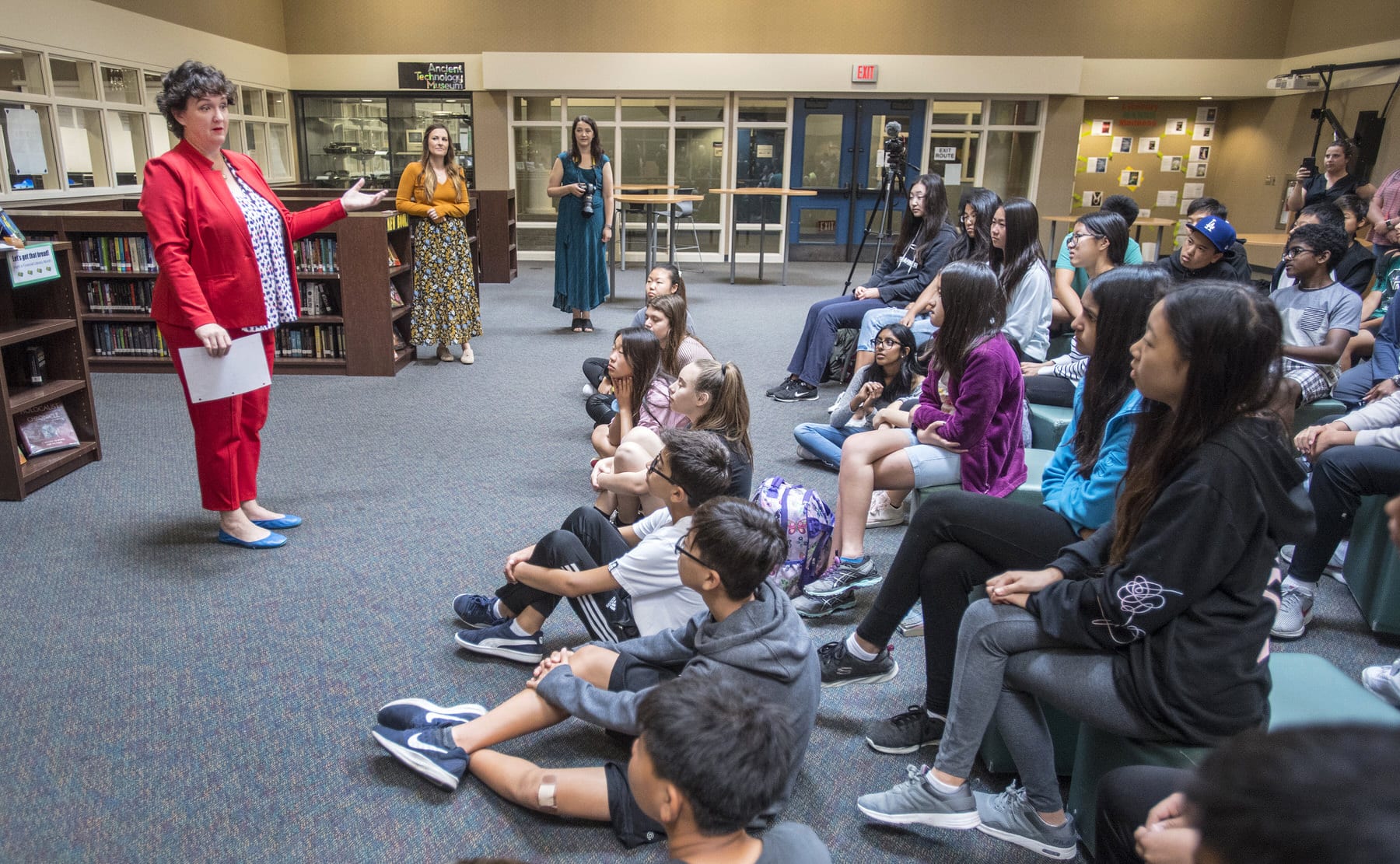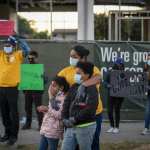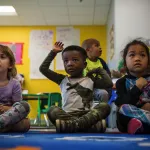Rep. Katie Porter, one of the only single moms in Congress with young kids, waded through 2020 like most other parents: without much of a safety net.
She entered her first term representing California’s 45th Congressional District in 2019 with three kids — now ages 9, 12 and 15 — and has quickly earned a reputation for fighting for working mothers (and eviscerating witnesses in questioning). This year, much of what she already knew to be true — that child care and school were the flimsy tethers that kept women in the workplace — became acutely obvious to much of the population, parents or not.
President Joe Biden’s $1.9 trillion American Rescue Plan includes $130 billion for school reopenings, $25 billion in emergency funds to stabilize the child care industry and a proposal to expand the child tax credit to as much as $3,600 per child, sent via monthly checks, and enhanced so that the poorest families can access the full benefit. His longer-term, $775 billion caregiving plan would stretch for 10 years and provide better wages for care workers and enhance options for home- and community-based care.
It’s in that context that Porter has recently reintroduced her Family Savings for Kids and Seniors Act, a bill that would tie to inflation the amount of pre-tax dollars parents can set aside to pay for things like preschool, day care, senior care, summer camp and afterschool care. Currently, the amount is $5,000 — a figure that has remained unchanged since 1986.
Had her bill been adopted in 2020, families could have set aside $11,800 in pre-tax dollars for dependent care.
Porter sat down with The 19th to discuss her bill and what other legislation she feels is essential in carving a path out of the caregiving crisis.
This interview has been edited for length and clarity.
So much of the story of caregiving this year is a gendered one. Talk to me about being a single mom during the pandemic. It’s always been challenging, but what has this past year taught you about caregiving? How did you manage it and how has it informed your priorities moving forward?
My job is somewhat different in that it involved being away from home so much. It’s more of a juggle, rather than here or not here. My kids are really good about it. If they hear me talking on a Zoom, they will crawl through the kitchen to the snack cupboard so they don’t appear on TV. They’ve gotten better about those things, just like I’ve gotten better about how to think about like, in order to make sure that my son gets on his remote schooling, I really can’t book anything during those 15 minutes because I won’t remember to remind him that he needs to go get on his remote schooling.
I have three kids. One’s in high school, one’s in middle school, one’s in elementary. None of them are in school at the same time. Obviously some of them entertain themselves, whether that’s an iPad, or play basketball in the driveway, or playing with toys or reading. But we’re definitely kind of straining our Wifi to its maximum.
I definitely have a feeling that I’m never doing just one thing. There was a sense before, when they were in the school, that they really weren’t my problem [during school hours]. And now, even if they’re on remote school, or whatever, I’m still here. I’m the one they come to if they stub their toe. I’m the one they look to for lunch. It is more of a constant presence and it’s tiring that way.
Has it made you think differently about the nature of caregiving? There’s not much of an infrastructure for it, but has it informed at all how you want to look at this big problem?
As a single working parent, I was pretty acutely aware of all of this. I have always known that, but for a quality public school system where I know my kids can be safe, I would not be able to work. But for having day care options, this would not not work. I’m fortunate that my children’s child care provider has continued to come during COVID, but obviously I can’t afford to have him here every hour of every day that I’m working. Do I stretch the budget and try to get the amount of child care that would really represent my need? Or do I live with less and juggle? I think I’ve definitely been doing the live with less and juggle because I don’t have the resources. And I think that is really, really common.
I think for people who are like, ‘Gee, the pandemic makes things hard.’ I just don’t hear parents saying that. It just wasn’t news in the sense of like, ‘Golly gee, didn’t know that.’ I think the people who are [saying this] don’t understand the level of fear and panic that people who are working parents felt the second schools closed, the second the stay-at-home orders started. Nobody gave a do-not-work order. They gave a stay-home order. And some people have to continue to go physically to work. That presents its own challenges about leaving kids unsupervised. I think a lot of parents question, ‘Are you still doing a good job as a parent?’ when every day is a question of how much iPad time you’re gonna allow.
You’ve reintroduced your Family Savings for Kids and Seniors Act, which is one of the various bills to address the child care crisis being proposed now. Why did you go this route?
This bill actually was one of the ideas that I came to Congress with. As a working parent, I was fortunate that my employers offered setting aside money that lets you pay for child care tax-free. But it has a limit of $5,000. And it doesn’t matter how many children you have.
I remember having my second child, but now my cost has doubled and I still only get $5,000. Then I had a third child. I always thought, ‘Who in Washington thought child care costs $5,000?’ Even after-school care for late elementary school, fourth or fifth graders, would exceed that. When I got to Congress I talked about wanting to do something about this with my staff. They came back to me with the answer: Ronald Reagan. Because that amount has not been adjusted for inflation since 1986. Child care has really increased in expense.
That bill is not a complete solution. It’s just one more tool.
One of the things I like about [the bill] is that it also covers senior care. This pandemic, because of the higher rate of potential death or severe illness to seniors, we’ve definitely seen people being burned on both ends. Just as there are fewer child care centers, there are also fewer safe options for seniors during this time.
What do you view as the best path forward to ease the incredible burden on caregivers — both parents and professional caregivers for children and seniors? What legislation do you feel we need to enact immediately?
The expanded tax credit for children is incredibly important because parents are facing more expense. They need more child care, if schools are closed or remote schooling or partially open.
One of the things that’s exciting to me is starting to see that not as an issue about helping parents or helping women or helping mothers, but as a broad economic issue. Hearing someone like [Treasury Secretary] Janet Yellen talk about women in the workforce, and what they add to GDP, that is incredibly meaningful to me. Sometimes I feel sort of like, you’re doing all this work and do people see it and is it valued? And it’s really great to have people like Joe Biden talking about this. His caregiving plan — that is part of his Build Back Better. It’s not just building back bridges, not just building roads. And to have him talk about caregiving and the caregiving workforce — putting the words caregiving and work even together — I think it’s really powerful.
You’re known for your tough questioning. I won’t make you do it on the spot now, but I am wondering more generally what your response or line of questioning might be for people who say that the expense of child care and elder care as outlined by the Biden administration — some $775 billion total over 10 years — is too costly and should be less ambitious?
We have to apply this, ‘How much would it cost?’ to look at both acting and not acting. So there’s always this sense that it would cost this much to do something, but somehow not acting is free. That’s never right. There’s a cost to taking a particular action and there’s a cost and risk to not taking a particular action. And I think that’s something that we need to get much better about spelling out for people. What is the harm of women exiting the workforce and staying out of the workforce? That’s a very measurable harm to our GDP, to our global competitiveness, to the development of talent.
I look back at how policies were talked about in some other periods in America: What if we don’t put a man on the moon? What does that mean for our global competitiveness? What if we don’t invest in science and research or public universities? We always do this, by the way, in national security; what if we don’t have this or that or the other thing?
We need to bring that same lens to what is the cost of doing it versus not doing it? And I think [child care] is something where there’s a lot more room to improve.
This is also a story of representation, and I know one of your first successes in Congress was passing legislation in the House that would allow candidates to use campaign funds for child care, elder care, dependent care and health care. How do you view the issue of representation now when we are debating topics like child care and better pay for caregivers that would most impact the people in the minority in Congress: women?
Representation does matter. We’re currently doing some work around the proposals on the expanded child tax credit — How would it affect married couples versus single parents? Why am I thinking about that? Because I am a single parent. I do think the diversity in Congress — of age, of experience, of career background, geography — matters. But it’s not enough just to elect the diversity, you have to also give it a voice.







